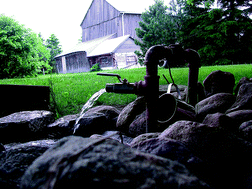Snow samples collected from hand-dug pits at two sites in Simcoe County, Ontario, Canada were analysed for major and trace elements using the clean lab methods established for polar ice. Potentially toxic, chalcophile elements are highly enriched in snow, relative to their natural abundance in crustal rocks, with enrichment factor (EF) values (calculated using Sc) in the range 107 to 1081 for Ag, As, Bi, Cd, Cu, Mo, Pb, Sb, Te, and Zn. Relative to M/Sc ratios in snow, water samples collected at two artesian flows in this area are significantly depleted in Ag, Al, Be, Bi, Cd, Cr, Cu, Ni, Pb, Sb, Tl, V, and Zn at both sites, and in Co, Th and Tl at one of the sites. The removal from the waters of these elements is presumably due to such processes as physical retention (filtration) of metal-bearing atmospheric aerosols by organic and mineral soil components as well as adsorption and surface complexation of ionic species onto organic, metal oxyhydroxide and clay mineral surfaces. In the case of Pb, the removal processes are so effective that apparently “natural” ratios of Pb to Sc are found in the groundwaters. Tritium measurements show that the groundwater at one of the sites is modern (ie not more than 30 years old) meaning that the inputs of Pb and other trace elements to the groundwaters may originally have been much higher than they are today; the M/Sc ratios measured in the groundwaters today, therefore, represent a conservative estimate of the extent of metal removal along the flow path.
Lithogenic elements significantly enriched in the groundwaters at both sites include Ba, Ca, Li, Mg, Mn, Na, Rb, S, Si, Sr, and Ti. The abundance of these elements can largely be explained in terms of weathering of the dominant silicate (plagioclase, potassium feldspar, amphibole and biotite) and carbonate minerals (calcite, dolomite and ankerite) in the soils and sediments of the watershed. Arsenic, Mo, Te, and especially U are also highly enriched in the groundwaters, due to chemical weathering: these could easily be explained if there are small amounts of sulfides (As, Mo, Te) and apatite (U) in the soils of the source area. Elements neither significantly enriched nor depleted at both sites include Fe, Ga, Ge, and P.


 Please wait while we load your content...
Please wait while we load your content...